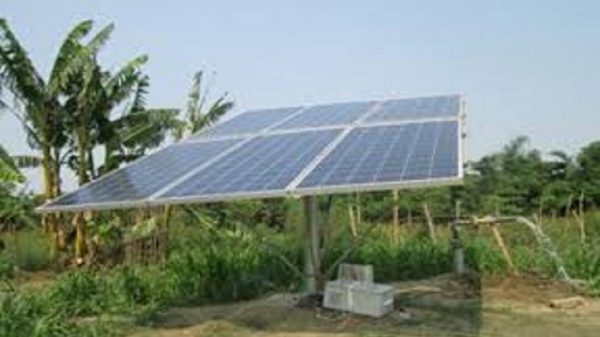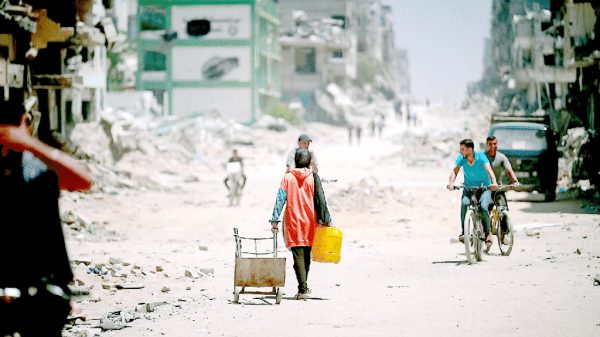Solar Pump and the Agricultural Revolution

The agricultural sector employs 40% of the world’s population. Despite this, many of the world’s smallholder farmers have minimal access to modern energy services (such as electricity, mechanical, and thermal energy) that have significant positive impacts on food security, gender empowerment, and rural poverty. Over the last few years, off-grid solar products, especially solar water pumps for irrigation, have improved to help farmers increase crop yields and income. Of late, the national plans (e.g., Power System Master Plan) and policy documents (e.g., National Energy Policy) illustrates a breakthrough in irrigation (and water resource management) is possible through deploying solar pumps.
Irrigation plays a vital role in the agriculture of the country, which is located in the tropical and sub-tropical delta. As the consequences of climate change become more real, improved irrigation will become an increasingly important mechanism for sustainable and drought-resistant agriculture, rapidly removing the need for fossil fuels. Studies indicate there is a massive potential of the solar irrigation system in Bangladesh. Solar pumps can provide sustainable solutions without requiring any fuel to reduce carbon emission and save millions in foreign currency.
Bangladesh has a land area of about 14.4 million hectares, of which 9.03 million ha (64%) are under cultivation. Irrigation is currently available to less than 50% of the land that can be irrigated in the Rabi season. At present, about 33% of the cultivable land (3.12 million ha) has irrigation facilities. Motorized pumps (DTW, STW, turbine pump, low lift pump, etc.), manual pumps (don, swing basket, treadle pump, and hand tube well), and recently solar pumps are using for irrigation purposes.
Diesel and electricity from the national grid are predominantly used in 1.6 million units of irrigation pumps, which are in operation in Bangladesh. Diesel-powered pumps account for 81% of the total at a considerable expense to farmers and the taxpayers in the form of subsidies. The remaining 19% of the irrigation units run on electricity from the national grid, which adds to the growing demand for electricity. The utilization of renewable energy is seen as ideal for reducing Bangladesh’s reliance on fossil fuel for agriculture. Solar irrigation pumps have the potential to provide for irrigation needs during the farming season while adding surplus generation to the grid during the off-season.
In the remote off-grid areas, the farmers remained worried over getting water for irrigation for a good harvest. In every Boro season, they had to hire a diesel-run pump and buy diesel to grow crops on the land. Moreover, a machine could not pump out enough water due to the depleting water level there, and they got poor yield. With the installed solar irrigation pump, farmers can now irrigate their lands without any hassle and make more profit than before as earlier they had to wait for days to get diesel for running their pumps for irrigation.
Solar energy irrigation project started in Bangladesh in 2010 under the initiative of Infrastructure Development Company Limited (IDCOL). In 2013, IDCOL initiated a pilot project with a target to install 1500 solar irrigation pumps across the country by 2018. So far, IDCOL has approved 1,429 solar irrigation pumps, with 1,186 of them are already operational, and the rest of is under construction. The installed solar-based irrigation pumps provide water on over 106,848 bighas of land rice cultivation.
Over the years, IDCOL discovered the enormous prospects of solar irrigation pumps due to its acceptance among farmers. They now have set the target of installing 50,000 solar- power irrigation pumps across Bangladesh by 2025 in a bid to promote alternative energy and limit reliance on fossil fuels. The projected solar-powered irrigation pumps will cover more than millions of bighas of land.
An increased number of people are getting interested in solar pumps due to their financial viability and lower cost. A farmer has to pay around 3000-4000 taka for each bigha of land as an irrigation charge during a crop season for diesel or electricity run pump. In contrast, for solar irrigation pumps, it is approximately 2,500-2,800 TK. The potential of the solar irrigation system in the country’s agriculture is vast. The average capacity of a solar irrigation pump is 18.5 KW, and it can irrigate 130 bighas of land. The pump of 18.5 KW size is capable of lifting 25 – 30 liters of water per day in local solar irradiation conditions.
The expansion of solar irrigation will cut dependency on diesel and electricity. Presently, Bangladesh has 1.34 million diesel pumps, and these pumps consume at least 1 million tons of diesel worth $900 million per year. The government provides a whopping amount of subsidy to keep its price affordable for farmers. On the other hand, about 3.20 lakh pumps are run by electricity to irrigate crops on a total of 54.48 lakh hectares in the dry season, and some 1,700-1,800 megawatts of electricity are consumed for irrigating rice fields.
The rapid expansion of more affordable solar-powered irrigation offers viable solutions that span the water-energy-food nexus, providing an excellent opportunity for smallholders to improve their livelihoods, economic prosperity, and food security. A smooth supply of water for irrigation will help to increase agricultural productivity. Substantiating these benefits, a study in India reported that 45% of farmers using solar pumps saw an increase of 50% or more in their annual incomes compared to rain-fed irrigation. Likewise, blessed by sunlight, African countries can greatly benefit from solar energy to make use of groundwater resources; however, there are implementation challenges that must be overcome. Capital costs must become more affordable, and better water governance is needed to help reduce inequalities and improve water management.
As in Asia, it is preventing groundwater over-use is critical but is possible with incentives created by linking solar irrigation to the development of national, or perhaps local, grids. Solar irrigation can be a win-win for climate change adaptation (i.e., less reliance on rainfall, increased and diversified incomes) and mitigation (renewable energy to grids, less reliance on diesel and electricity pumps). If we get it right, solar irrigation can create a win-win-win-win for food, water, energy, and climate.
Modern solar-powered systems offer useful tools to improve water governance. For instance, electronic controller devices help to provide real-time inputs regarding storage tank levels, pump speed, and borehole water levels that could ultimately trigger regulatory decisions to pre-empt excessive use remotely. India and Egypt are both experimenting with such an approach.
Solar panels produce energy even at times when no irrigation is needed, opening up significant opportunities to run rice huskers, mills, water purifiers, and cold storage units, all contributing to rural development and incomes. In some cases, solar power can also become a “remunerative crop” if farmers are encouraged to reduce over-pumping water by opting to pool and sell their surplus energy to the electricity grid.
Diesel-run pumps are cheaper than solar-powered ones, but their operating costs are quite high and depended mainly on diesel prices. Solar-powered pumps, on the other hand, are relatively expensive, but the source of energy is free, and there are no additional operating costs except the maintenance.
Revolutionizing Bangladesh irrigation is largely hinge on enacting a “Solar Energy Policy.” This policy must be stakeholder-driven. Key objectives of this policy instrument would be (a) achieving “optimal energy mix” of conventional and renewable power ensuring energy security, (b) promoting cutting-edge technologies in solar energy generation and storage, (c) facilitating improved solar energy infrastructure, (d) investing in developing innovative financial mechanisms, and (e) facilitating research and innovation in the field of renewable energy.
The writers are Associate Professor and PhD Fellow, respectively in the Department of Agricultural Extension & Information System, Sher-e-Bangla
Agricultural University, Dhaka.




























Leave a Reply